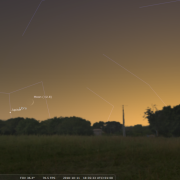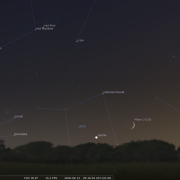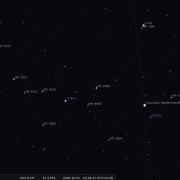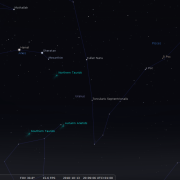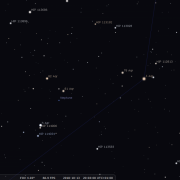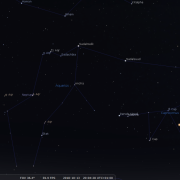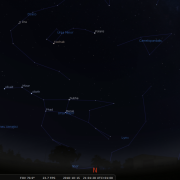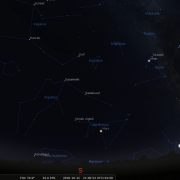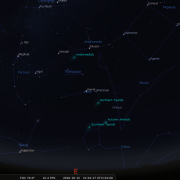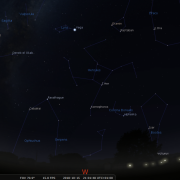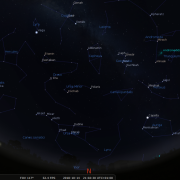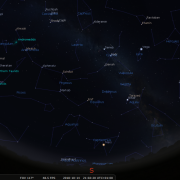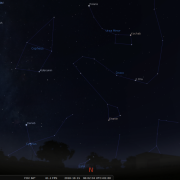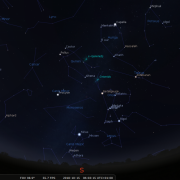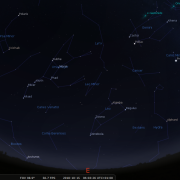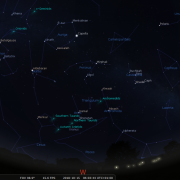In this month's Sky Notes:
Planetary Skylights
 Jupiter lingers extremely low in the evening twilight, and although it technically departs our skies early next month, in reality it’s so low that it must be counted as purely a brief naked eye object only. Look for it on the 11th around 18:40h, lower left of a crescent moon just above the SW horizon. You will require a flat, unobstructed horizon to spot it.
Jupiter lingers extremely low in the evening twilight, and although it technically departs our skies early next month, in reality it’s so low that it must be counted as purely a brief naked eye object only. Look for it on the 11th around 18:40h, lower left of a crescent moon just above the SW horizon. You will require a flat, unobstructed horizon to spot it.

 Saturn gradually edges further toward the SW, sitting above the ‘teapot’ asterism in Sagittarius. Look for a conspicuous ‘star’ quite low down. It will be observable all month, but do so as soon as twilight deepens as the planet sets by 21:30h at the start of October and by 18:30h at the end of the month. The rings are favourably orientated, but you will have to wait for those steadier ‘seeing’ moments to fully appreciate this wonderful spectacle. The brighter speck of light near Saturn will be Titan; its largest moon. Our Moon lies nearby Saturn on the 14th and 15th.
Saturn gradually edges further toward the SW, sitting above the ‘teapot’ asterism in Sagittarius. Look for a conspicuous ‘star’ quite low down. It will be observable all month, but do so as soon as twilight deepens as the planet sets by 21:30h at the start of October and by 18:30h at the end of the month. The rings are favourably orientated, but you will have to wait for those steadier ‘seeing’ moments to fully appreciate this wonderful spectacle. The brighter speck of light near Saturn will be Titan; its largest moon. Our Moon lies nearby Saturn on the 14th and 15th.
 Mars resides low above the south horizon, a conspicuous fiery presence to the naked eye. With the red planet located well below the ecliptic, and with a planet wide dust storm obscuring the surface for almost two months, observations have been rather hampered. The good news is that at least the dust storm has abated and if seeing is steady (you will have to be patient at the eyepiece). A modest telescope will reveal surface markings, including the polar caps. The Moon resides nearby on the 17th/18th.
Mars resides low above the south horizon, a conspicuous fiery presence to the naked eye. With the red planet located well below the ecliptic, and with a planet wide dust storm obscuring the surface for almost two months, observations have been rather hampered. The good news is that at least the dust storm has abated and if seeing is steady (you will have to be patient at the eyepiece). A modest telescope will reveal surface markings, including the polar caps. The Moon resides nearby on the 17th/18th.
 Uranus reaches opposition later this month (24th) and at magnitude +5.65 should be easily visible in a pair of binoculars, but to discern its very small grey/green disk a telescope will be required. The planet is located over in the east, to the left of the ‘V’ in Pisces, in particular the star omicron psc; Torcularis Septentrionalis, by some 2 degrees (less than a binocular field). ‘Herschel’s planet’ will be better placed in the south later next month during mid evening. The full moon lies below it on opposition date.
Uranus reaches opposition later this month (24th) and at magnitude +5.65 should be easily visible in a pair of binoculars, but to discern its very small grey/green disk a telescope will be required. The planet is located over in the east, to the left of the ‘V’ in Pisces, in particular the star omicron psc; Torcularis Septentrionalis, by some 2 degrees (less than a binocular field). ‘Herschel’s planet’ will be better placed in the south later next month during mid evening. The full moon lies below it on opposition date.
 Neptune is located in the south within the constellation of Aquarius, approximately a binocular field lower left of the asterism known as the ‘water jar’ and the a few degrees to the left of Lamda Aquarii. You will require a telescope to identify it, appearing as a tiny blue/grey disk. Look for it just below /left of 81 Aqr. The moon resides 5 degrees below on the 20th.
Neptune is located in the south within the constellation of Aquarius, approximately a binocular field lower left of the asterism known as the ‘water jar’ and the a few degrees to the left of Lamda Aquarii. You will require a telescope to identify it, appearing as a tiny blue/grey disk. Look for it just below /left of 81 Aqr. The moon resides 5 degrees below on the 20th.
Meteors

The Orionids (Oct 16- 27) are the months most reliable shower, peaking this year on Oct 21/22. Unfortunately an almost full moon will severely hamper observations and the peak rate of 20 or so will be correspondingly reduced to perhaps a strong handful. Like the May Eta Aquarids, Orionids are associated with Comet Halley, but are more favourable for northern hemisphere observers due to the radiant being situated high in the S by early morning hours. Orionids are swift, often producing persistent trains.
The Southern Taurids peak on the 10th, however rates will be little more than sporadic levels (5 per hour)
The weak Piscid shower has three peak dates, Oct 13th being the optimum one. Observed rates are little better than sporadic levels - around 3-7 per hour. Piscid meteors are often slow, of long duration, but not very brilliant.
Perhaps the most interesting shower is the Giacobinids or Draconids (Oct 6 -10th peaking on the 8th) which are associated with the periodic comet Giacabini- Zinner (6yrs) The shower is very erratic, but can produce outbursts of activity. This year evidence from the BAA and IMO again suggests that this may be the case. Observing over the night of the 8th, rates exceeding 25 per hour are possible in the early morning hours and with no moonlight present an observer is likely to see at least a dozen. The Draconids; associated with the constellation of Draco, which is located high up in the NW winding its way between the two celestial bears of Ursa Major and Minor.
Comets
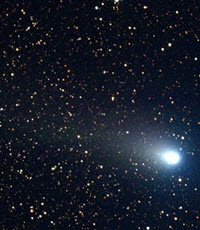
Comet 21P/Giacobini-Zinner
(N.A.Sharp/NOAO/AURA/NSF)
It was hoped Comet 21P/Giacobini-Zinner may have become a naked eye object earlier last month, but in the end it just failed, reaching +6.6 in magnitude. The comet, which was circumpolar during August when in Cassiopeia, raced down through Auriga passing close to Capella on Sept 3rd and the open clusters M38, M36 and M37 the following week, by which time it had reached perihelion. Comet 21P then journeyed through Gemini passing close to M35 on the night of the 15/16th. It is currently a morning object tracking down the Gemini/Orion border, heading into Monocerus and will lie close to the star cluster M50 on Oct 8th before heading down left of Sirius on the 14/15th. By the end of the month it will have faded to 10th magnitude. See charts in Night Scenes 2018 or look on the web for up to date finder charts.
Comet 46P/Wirtanen may become a naked eye comet by early/mid December (large intake of breath). Currently residing well to the south in Fornax, 46P will move up into the lower part of Cetus by December, then Eridanus, before back into Cetus once more. During the middle of December it could reach +4.5, detectable to the naked eye. We shall keep you posted – comets!!
October 2018 Sky Charts
|
Looking North
Mid-October - 21:00h |
Looking South |
|
Looking East
Mid-October - 21:00h |
Looking West
Mid-October - 21:00h |
|
Northern Aspect
Mid-October - 21:00h |
Southern Aspect
Mid-October - 21:00h |
| Looking North (Early) Mid-October - 06:00h |
Looking South (Early) Mid-October - 06:00h |
| Looking East (Early) Mid-October - 06:00h |
Looking West (Early) Mid-October - 06:00h |
Additional Image Credits:
- Planets and Comets where not otherwise mentioned: NASA
- Sky Charts: Stellarium Software
- Log in to post comments

